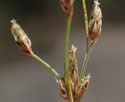Bulbostylis capillaris (Dense-tuft Hairsedge)
| Also known as: | Tufted Hairsedge |
|---|---|
| Genus: | Bulbostylis |
| Family: | Cyperaceae (Sedge) |
| Life cycle: | annual |
| Origin: | native |
| Habitat: | sun; dry sandy or rocky soil; prairies, roadsides, rock outcrops, beaches, waste places |
| Fruiting season: | July - October |
| Plant height: | 4 to 12 inches |
| Wetland Indicator Status: | GP: FACU MW: FACU NCNE: FACU |
| MN county distribution (click map to enlarge): |  |
| National distribution (click map to enlarge): |  |
Pick an image for a larger view. See the glossary for icon descriptions.
Detailed Information
Flower: 

![[photo of spikelet clusters]](/udata/r9ndp23q/pd3/bulbostylis-capillaris-072516-32-t.jpg) One to 7 spikelets (flower clusters) on slender stalks of varying lengths all arising from the tip of the stem, usually an open cluster, sometimes more compact. The lowest spikelet has a scale-like bract at the base, its midrib with a bristle-like or leaf-like extension that usually over-tops the spikelet. Spikelets are erect to ascending, lance-shaped in outline, red-brown, 3 to 5 mm long (less than ¼ inch), and few-flowered.
One to 7 spikelets (flower clusters) on slender stalks of varying lengths all arising from the tip of the stem, usually an open cluster, sometimes more compact. The lowest spikelet has a scale-like bract at the base, its midrib with a bristle-like or leaf-like extension that usually over-tops the spikelet. Spikelets are erect to ascending, lance-shaped in outline, red-brown, 3 to 5 mm long (less than ¼ inch), and few-flowered.
![[close-up of spikelet]](/udata/r9ndp23q/pd3/bulbostylis-capillaris-7-16-1-t.jpg) Flowers are perfect (both male and female parts), each with 1 or 2 stamens, a 3-parted style, and subtended by a scale. Scales are 1.5 to 2 mm long, egg-shaped, blunt to pointed at the tip, hairless or minutely hairy near the tip, red-brown with a prominent green midrib that rarely extends slightly at the tip.
Flowers are perfect (both male and female parts), each with 1 or 2 stamens, a 3-parted style, and subtended by a scale. Scales are 1.5 to 2 mm long, egg-shaped, blunt to pointed at the tip, hairless or minutely hairy near the tip, red-brown with a prominent green midrib that rarely extends slightly at the tip.
Leaves and stems: 


![[photo of plant base]](/udata/r9ndp23q/pd3/bulbostylis-capillaris-6254378-16-t.jpg) Leaves are basal and alternate on the lower stem, erect to ascending to spreading, hairless, wiry with rolled-in edges (involute), up .5 mm wide, up to a third as long as the flowering stem. Sheaths are prominently ribbed on the back. Stems are also thread-like, erect to ascending, unbranched, 3-sided in cross-section, hairless, green, and multiple from the base forming clumps, the clump of stems often of widely varying lengths.
Leaves are basal and alternate on the lower stem, erect to ascending to spreading, hairless, wiry with rolled-in edges (involute), up .5 mm wide, up to a third as long as the flowering stem. Sheaths are prominently ribbed on the back. Stems are also thread-like, erect to ascending, unbranched, 3-sided in cross-section, hairless, green, and multiple from the base forming clumps, the clump of stems often of widely varying lengths.
Fruit: 
![[photo of mature spikelet and achenes]](/udata/r9ndp23q/grass/bulbostylis-capillaris-716-2-t.jpg) Achenes (seeds) are about 1 mm long, yellowish to pale brown, 3-sided in cross-section, urn-shaped in outline, the surface covered in cross-wrinkles, and with a tiny cap-like appendage (tubercle) at the tip, and lacking any bristles around the base.
Achenes (seeds) are about 1 mm long, yellowish to pale brown, 3-sided in cross-section, urn-shaped in outline, the surface covered in cross-wrinkles, and with a tiny cap-like appendage (tubercle) at the tip, and lacking any bristles around the base.
Notes:
Bulbostylis capillaris is an occasional sedge of dry, sandy or rocky soils. In Minnesota, it is most often found on sandy beaches or dunes and in rock outcrops, growing in the thin soil of cracks and shallow depressions. When stems have a single spikelet it may be mistaken for an Eleocharis species, which lack any bladed leaves and usually have bristles around the base of the achenes. It may also be mistaken for Fimbristylis autumnalis, a more rare species which has broader, flat leaves, flattened stems and spikelet stalks, the spikelet clusters are more numerous, often in compound (branched) clusters, and achenes are rather smaller, are variably warty especially around the base, and lack a tubercle.
Native Plant Nurseries, Restoration and Landscaping Services ↓
More photos
 Bulbostylis capillaris plants
Bulbostylis capillaris plants Bulbostylis capillaris plants
Bulbostylis capillaris plants Bulbostylis capillaris plants
Bulbostylis capillaris plants more spikes
more spikes more spikes
more spikes comparison of Bulbostylis capillaris and Fimbristylis autumnalis spikelets
comparison of Bulbostylis capillaris and Fimbristylis autumnalis spikelets comparison of Bulbostylis capillaris and Fimbristylis autumnalis achenes
comparison of Bulbostylis capillaris and Fimbristylis autumnalis achenes
Photos by K. Chayka taken in Anoka and Yellow Medicine counties. Photos by Peter M. Dziuk taken in Renville and Yellow Medicine counties.
Comments
Have you seen this plant in Minnesota, or have any other comments about it?






